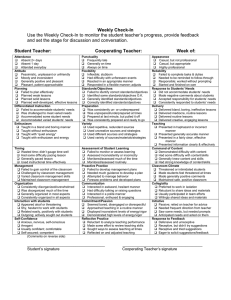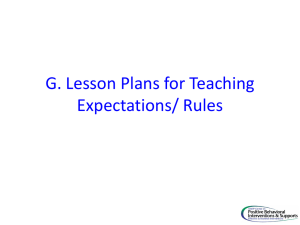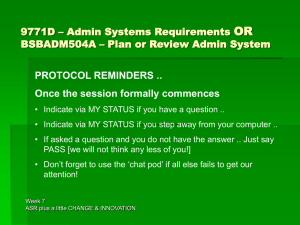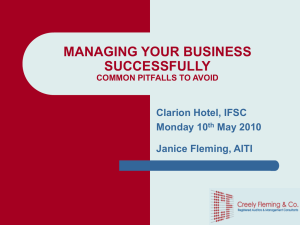Choosing Rules and Procedures
advertisement
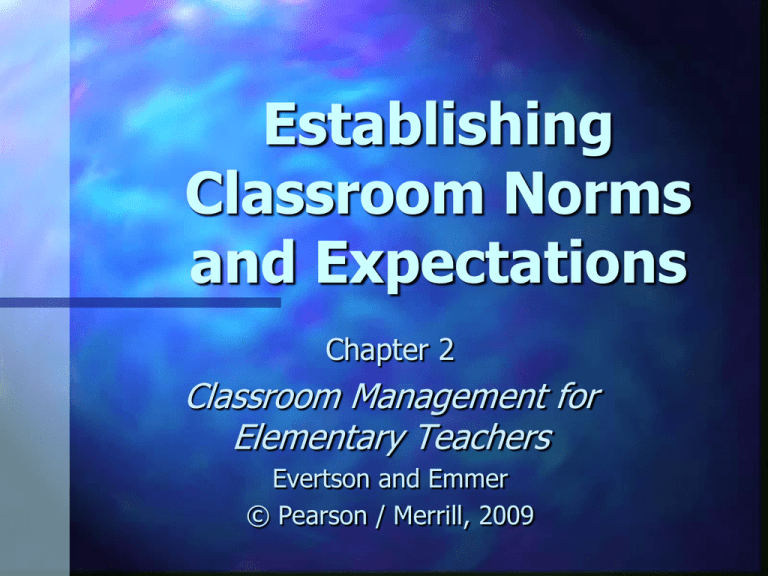
Establishing Classroom Norms and Expectations Chapter 2 Classroom Management for Elementary Teachers Evertson and Emmer © Pearson / Merrill, 2009 Definition of Terms Goals Focus on target aspirations Not necessarily attained every day – by the end of the year or a life Personal A teacher’s beliefs and goals he or she sets will influence expectations communicated to students Definition of Terms, contd. Expectations Desired behaviors or outcomes Teacher’s expectations should be known to students (make VISIBLE the INVISIBLE expectations) Teaching rules and procedures directly Practicing Consistently responding to students’ behaviors Definition of Terms, contd. Norms When behaviors that teacher and students expect become routine Definition of Terms, contd. Rules Govern relationships with others, time, space, materials Rules identify general expectations or standards for behavior May indicate unacceptable behavior as well as expected, appropriate behavior Do not change Are few in number Definition of Terms, contd. Procedures Procedures are usually directed at accomplishing something Communicate expectations for behavior as they apply to a specific activity Govern ways to get things done Change according to need Are many in number Examples Sharpening pencils Collecting assignments Using the bathroom Why All Kinds of Classrooms Need Rules and Procedures All classrooms need rules and procedures. Form follows function Rules and procedures must be carefully chosen. Rules and procedures must be taught. Identifying School Rules and Procedures 1. Behaviors that are specifically forbidden 2. Consequences for rule violations 3. Example: running in hall Example: reporting student to school office Administrative procedures that must be handled during class time Example: calling roll; collecting lunch money Planning Your Classroom Rules Select a few 4 to 8 (Evertson, et al.) 3 to 5 (Wong) State them in positive terms State them clearly Make them consistent with the school rules Sample Rules 1. 2. 3. 4. Respect and be polite to all people Be prompt and prepared Listen quietly while others are speaking Obey all school rules Respect other people’s property “Respect other people’s property” Keep the room clean and neat Pick up litter Return borrowed property Do not write on the desks Do not use another person’s things without permission Use of Classroom Rules Discuss with and model for students Practice and role play Post in the room Provide a copy to students Send a copy home to parents Post on website Refer to as needed to remind students of specific behavior • RE-ENFORCE CONSISTENTLY • Be consistent • Be sure that stated rules and functional rules are the same SAY WHAT YOU MEAN – MEAN WHAT YOU SAY! Student Participation in Rule Setting Democratic principles in action Promotes ownership and responsibility Discussion clarifies and provides examples The Process of Developing Rules Whole class discussion Possible rules are suggested and recorded Categorize the suggested rules Develop a title for each category The title may become the rule Rule infractions result in natural or logical consequences A teacher who establishes reasonable rules and procedures who provides an understandable rationale for them who enforces them consistently Will find that the majority of students are willing to abide by them Planning Classroom Procedures Procedures for Room Use Teacher’s desk and storage area (Blue) Student desks and other storage areas (Blue) Storage for common materials (Red) Drinking fountain, sink, pencil sharpener (Red) Bathrooms (Yellow) Centers/stations and equipment areas (Green) Computer stations (Orange) Procedures for Independent Work and Teacher-led Activities Student attention during presentations (Red) Student participation (Blue) Talk among students (Green) Obtaining help (Yellow) When individual work has been completed (Orange) Transitions Into and Out of the Room Beginning the school day (Green) Leaving the room (Yellow) Returning to the room (Orange) Ending the day (Blue) Develop the procedure. Use role play or a skit to model for the rest of the class. Procedures for Small-Group Instruction Getting the class ready for the activity Student movement into and out of the group Expected behavior of students in the group Expected behavior of students outside the small group Use of materials and supplies Procedures for Cooperative Group Activities Introduced when first used Roles and tasks are taught and practiced Consider using role/task cards Roles Roles must be assigned and taught 1. Reporter / Recorder Clarifying Task Focuser Turn Maker Clock Watcher Encouraging Peace Keeper 2. 3. 4. 5. General Procedures Distributing materials Interruptions or delays Restrooms Library, resource room, school office Cafeteria Playground Fire and disaster drills Classroom helpers Checklist 2 (pp. 40-41)



